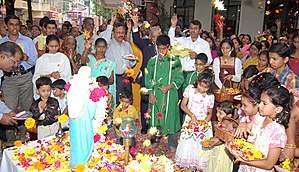Monti Fest
Monti Fest is a major Catholic festival held on 8 September every year by the Konkani community of south-western India.[1] This festival celebrates the Nativity of the Blessed Virgin Mary and in the Mangalorean Catholic community involves blessing of Novem (new crops).[2] In certain Goan Catholic dialects the festival's name is corrupted to "Moti Fest".[3]

According to the Konkani scholar, Fr. Pratap Naik, S.J., the festival derives its name from the Capela de Nossa Senhora do Monte (Portuguese for 'Chapel of Our Lady of the Mount') in Old Goa.[4] The chapel was constructed in AD 1519 on a hillock commanding a view of the Mandovi River on the orders of Afonso de Albuquerque in honour of Our Lady.[5] Its feast on 8 September, called Monti Saibinichem Fest (Konkani for 'Lady of the Mount Feast'), had been started in the sixteenth century and continues to this day. Since, flowers and garlands are an integral part of the celebration, the Konkani epithet Fulanchem Fest (Feast of flowers).[6]
Father Naik had the following observations: According to the Hindu calendar after Shravan month, Bhadrapad month commences. On the fourth day of this month comes Ganesh Chaturthi. For this feast all members of the Goan Hindu family gather and celebrate from one-and-half to ten days. During this festive period Ganpati's image is installed in the house and flowers are offered to it daily. On one day during this festive period new corn is ceremoniously partaken. The Christianisation of Goa led to the mass conversion of Hindus from Ilhas de Goa (Tiswadi) and Jesuits taught the new converts to offer flowers to honour of Monti Sabin (Lady of the Mount) just as they offered flowers to Ganpati before their conversion. Thus, the Nativity feast which is celebrated all over the Catholic world on 8 September came to be called Monti Saibinichem Fest (Lady of the Mount Feast) in Goa. The Konkani-speaking converts of those days followed the Hindu traditions associated with Ganpati festival and celebrated the new corn fest with vegetable menu on 8 September. Thus was born today's Monti Fest. It is significant that Fr. Joachim Miranda, who initiated Monti Fest at Monte Mariano Church, Farangipet, Canara in AD 1763, was of Goan Catholic origin and would have been familiar with the festal celebration in Goa. Thus, Goa is said to be the original host of Monti Fest.[4]
Though Tippu Sultan destroyed the churches of Canara, he spared the Monte Mariano Church at Farangipet in deference to the friendship of his father Hyder Ali with Father Miranda.[7]
Notes
- Dsouza, Anil (7 September 2019). "Monthi Fest – Much More than Tradition". Daijiworld Media Pvt Ltd, Mangalore. Retrieved 10 September 2019.
- Lobo, Dean (8 September 2017). "Monti Fest, novem jevan and vorn...join in the Mangalorean feast". The Times of India. Retrieved 10 September 2019.
- Couthino, Jenny (9 October 2008). "Moti Fest, pork sausages and Church of Qatar". Merinews. Archived from the original on 27 June 2019. Retrieved 10 September 2019.
-
Monterio, John (8 September 2015). "Monthi Fest rooted in Goa - Not in Farangipet?". Daijiworld Media Pvt Ltd, Mangalore. Retrieved 10 September 2019.
In his article published in Raknno, the Konkani weekly of the Diocese of Mangalore, dated 3 September 2015, Fr. Pratap Naik, S.J., opines that the festival originated in Old Goa during the sixteenth century AD.
- "Church of Our Lady of the Mount: Church in Old Goa". Lonely Planet. Retrieved 10 September 2019.
- "The feast of Our Lady of the Mount at Old Goa". The Times of India. 11 September 2017. Retrieved 10 September 2019.
- Patrao, Michael (7 September 2019). "Friendship anchors a harvest fest". The Deccan Herald. Retrieved 10 September 2019.